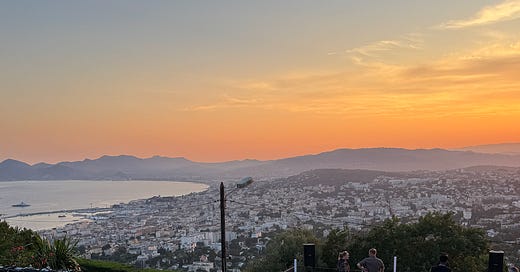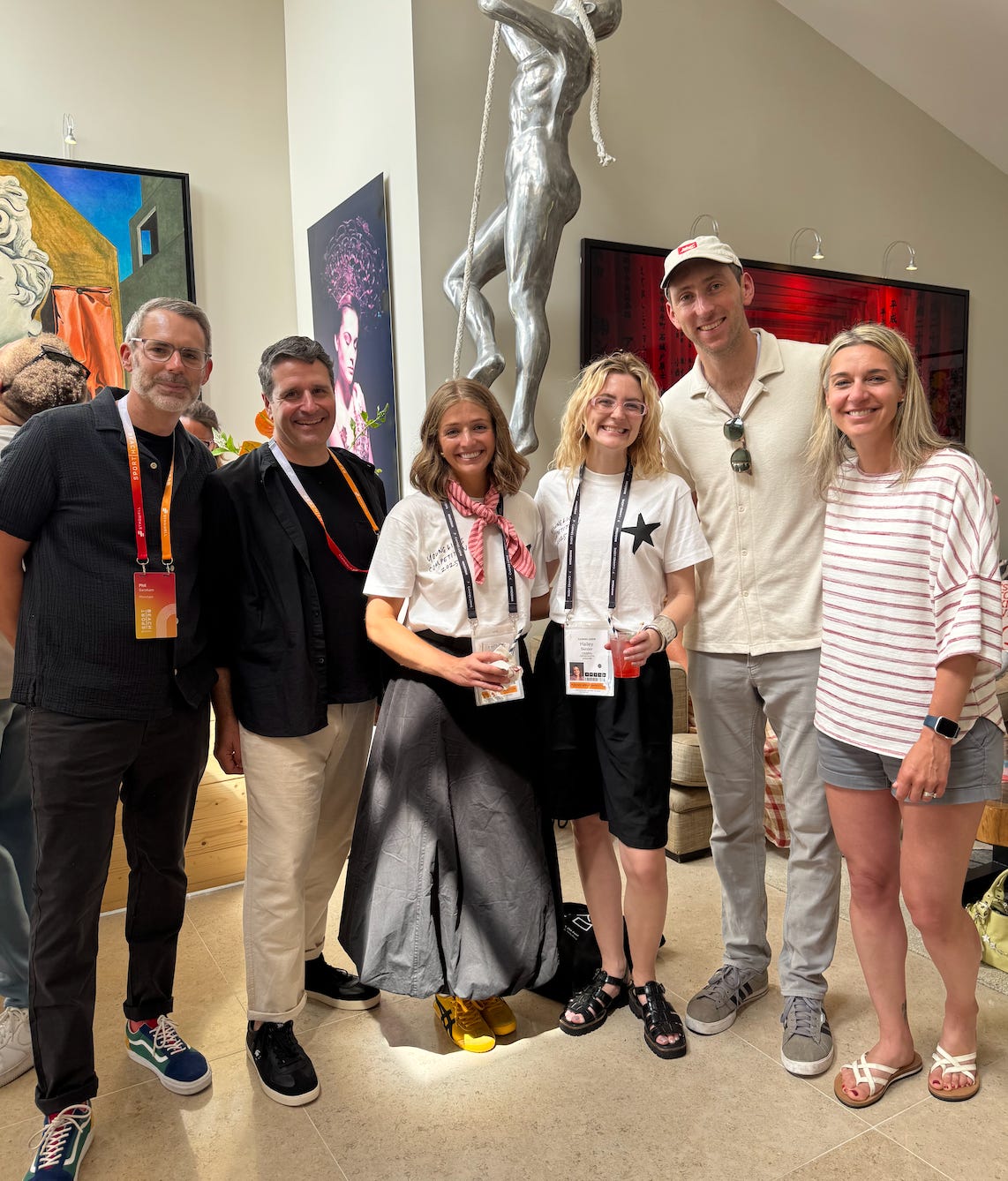Creative conversations in the Côte d'Azur.
Lessons from the voices and ideas that shaped Cannes Lions 2025.
Like most events of its scale and impact, Cannes Lions is an experience based almost entirely on what you make of it. Ask a dozen people there for their takeaways from the week, and you’re likely to get a dozen answers that make you believe none of these people attended the same festival. And yet, there is an enduring throughline that sets the tone...
...the belief that creativity still matters, perhaps more than ever. And the creative process and its people must be protected (and celebrated) at all costs. For one week in the South of France, rosé, linen, and yachts form a makeshift protective barrier over an industry mired in change. Facing the threat (or opportunity) of AI, macroeconomic and geopolitical pressures, and the ever-present challenge of defending margins, thousands of creative leaders descend upon Cannes with the hope that they’ll leave with a spark.
A new connection. A new idea. A new purpose.
In my second-year attending, I was a tad bit more prepared for what to expect. And the team that joined me from Monotype was bigger; we brought nine lovely colleagues, allowing us to spread out and cover more throughout the week. No doubt you'll have likely already read more definitive recaps from Cannes Lions 2025, including the big keynotes, product announcements, etc., but here I will throw my metaphorical hat into the ring as well. Because this experience felt unique and purposeful, and reinforced many of the concepts that I am carrying in our present creative environment. And of course, because I write a column on creativity, so, I am obliged to contribute to the noise 😊.
The future is bright. Mindset is everything.
One of the more meaningful partnerships I’ve had the privilege to participate in over the past couple of years has been sponsoring on behalf of Monotype the Team USA Young Lions design competition, in the “Print” category. The best-and-brightest advertising professionals under 30-years-old compete regionally for the chance to attend Cannes Lions and compete on the international stage.
On the first day of this year’s event, my colleagues and I attended a welcome reception for the winners, which celebrated their regional accomplishments and allowed industry luminaries to wish them well before they headed into isolation to work on their briefs for the next few days.
We met Kendelle Cragun and Hailey Skinner from Crispin, the winners of this year’s category. And we also saw the two women who had won our category last year, Victoria Rocha and Chloe Bayhack, of BBDO and Ogilvy, respectively. They were back after winning in a new category. Both were recently named to the AdWeek Creative 100 list of the top rising agency talent that is shaping culture. And when we caught up with Chloe on Monday, she had just won her first Gold Lion Award earlier in the day. Truly, this competition is a launching pad for creative leaders, giving them visibility and confidence in their ideas while bringing back acclaim to their employers. This year, we took our sponsorship a bit further too, with our Senior Executive Creative Director Charles Nix designing the official “kit” for Team USA.
Seeing the excitement of these competitors reaching for their dreams is always the perfect way to set the tone for the week. And it is a reminder to be grateful.
In Cannes you will find many veterans of the ad game, folks who have been to the festival for 5, 10, 20 or more years. And so often you will find yourself in conversations with people lamenting the fact that they have to go to this noisy event. Maybe it is because I’m still new, or maybe it is because I’ve worked my ass off in all kinds of jobs to get the chance to be in a place like this (I submitted my book for a talk in 2019 when I published it, it’s been on my vision board to get a seat to this festival for a while). But I much prefer to spend time talking with people who get to go to Cannes, versus the people who have to go to Cannes.
In fact, I received some playful ribbing from my UK colleagues during the week, who said “you get so excited about the most mundane things.”
“Oh, look at how much shade we have here!”
“Wow, what a beautiful table setting!”
It is true, I’m easy to please. But it is because I realize that in the creative world, getting to go to the South of France to do your job on a beach or a yacht is not f*cking normal, and I’ll never take it for granted. As I took to saying every time something magical happened throughout the week, “I love this shit!”
Partnerships are a winning growth strategy.
I recently was speaking with an executive who saw how much I was pushing for investment into events and activations. He asked me why I care so much about events, and if I wanted to be an event producer. The truth is, no, although as I wrote recently, producing events is one of the best learning opportunities I’ve had in my “business” career.
I am so bullish on events in a post-pandemic world because they work. There is a sort-of magic to a place like Cannes Lions that can’t be reflected entirely in a CRM or in a report. Running into a prospective customer in a cafe you’ve been chasing for months. Meeting someone and hitting it off that you’d never connected with, then finding ways to build together. I attended a marketing leaders' breakfast with an invite from someone I met in a prior role. Daisy Beldon (whom I met when she was at Canva) invited us and a few of our clients to an epic closing dinner she and her colleagues at Epidemic Sound were hosting at their villa. There we met so many lovely people we could collaborate with (type & sound, what could be better?!). I even ran into Bruno Ulloa (more on him later), a young media executive who I know because we did comedy together at the Groundlings in Los Angeles 7 years ago.
There is a reason that I met so many small business owners, consultants, freelance art directors, and more that had bootstrapped a trip to Cannes, couch-crashing and finding meals at activations. They do so because they know that being in proximity might offer them a chance to change their careers and their lives. That’s special.
--
At the center of our strategy at Cannes is smart, strategic partnerships. And my philosophy on partnerships is simple:
Pick the right partners, then get out of their way.
And damn do we have great partners. This year, we activated with two of our favorites. First, we set up a welcome luncheon with our friends at Pantone (color & type, what could be better?!), which was produced by the team at The Development. We planned for ~25-30 creative leaders to join us and nearly 60 showed up (thankfully, we were able to make space). The programming? Nothing.
“Creative Conversations” is how the event was billed, and it is exactly what happened. Designers, CMOs, Art Directors, agency leaders, musicians, creators, and more all came together to break bread and find new connections. I connected with so many lovely people including Bennie F. Johnson of the AMA, Amy Tunick of NCM, Michaela Washmon of Cannes Lions, Anthony Kennedy of Ion Group, Marisa Harary of The Free Press, on and on. My only regret is not having the chance to spend more time with each person!

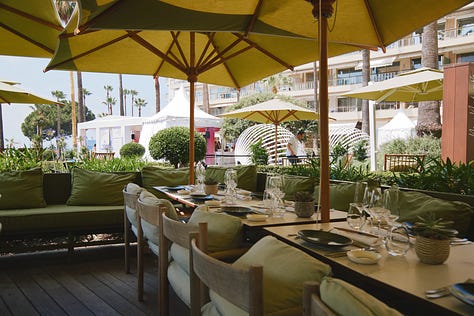
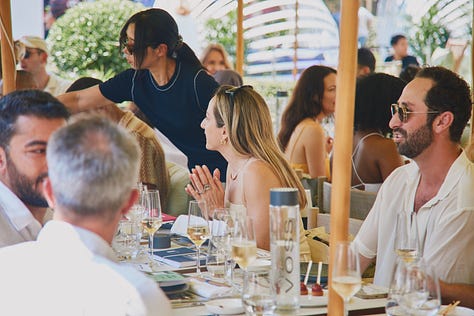
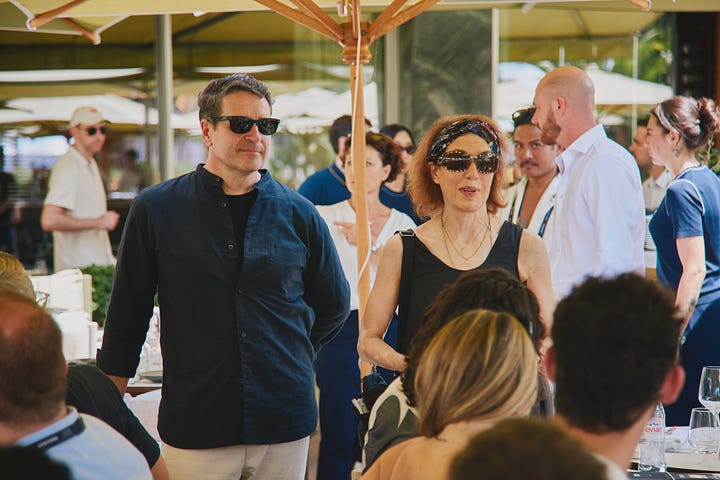

The team at The Development, specifically R John Fidelino and Diana Alickaj, did a phenomenal job on this event working with Monotype’s Marketing Strategy lead Candice Smith. We love showing up with Pantone and I expect we’ll continue to do more of these so look out for us at notable industry events later this year.
Our primary activation was in partnering to sponsor COLLINS House, a curated collection of programming and people set just above the Croisette (and away from the madness). You may recall we partnered with the COLLINS agency team to produce a meaningful event at SXSW a few months ago, and having briefly attended COLLINS House Cannes in its inaugural year in 2024, we knew we had to be part of what they were building in 2025.
In a chateau built in the 1800s, creative leaders joined throughout the week for peaceful meals, cold drinks, and surprising programming that featured industry luminaries, creative legends, and up-and-coming talent reshaping the creative landscape.






While Oscar-winner Taika Waititi’s session was a highlight, as was a surprise drop-in from Gap CEO Richard Dickson, or sessions with Inventor & Founder of Earos, Ronnie Madra, former head of creative at Disney Jean Batthany, CMO of WalMart William White, Creative Chairperson of Accenture Song Nick Law, on and on and on, the highlight for me came in the evening each day, when the programming subsided, the music began, and people sat with their feet in the pool and a glass of wine talking shop, or art, or nothing at all. The “magic” hour, as it were.
Creativity is Culture and Culture is Creativity.
Of course, a week in Cannes cannot only be about 1:1 connection. I tried to take in as much relevant programming as I could, which is an overwhelming task given the quantity and quality of discussions spread out in nearly every venue imaginable.
Of the many themes present at Cannes Lions 2025, here are a few that stood out to me.
Audiences cannot be entirely defined by data.
One of the more enlightening panels I attended was at the famed Inkwell Beach activation, “Programming the Narrative: From Data Pipelines to Cultural Power.” Featuring my friend Bruno Ulloa, President and COO of LatiNation, along with Charles Cantu, CEO & Founder of Reset Digital and Rahsan-Rahsan Lindsay, President & CEO of Moviefone Media, the panel focused on how emerging and legacy platforms are reflective of and driving cultural movements in a data-first world.
Among several engaging points made by the panelists, much of the discussion centered on the nuances of culture. Lindsay noted how he likes to listen to reggaeton music, so many of his algorithms inaccurately assume he speaks Spanish when he does not. Datasets by their very nature do not enable individualistic engagement with audiences. And all-too-often, this leads to a homogenous media landscape, when there are so many valuable opportunities when creating in the nuance.
Ulloa noted that at LatiNation, they make content by Latinos but for everyone, in a way aligning to Lindsay’s music preferences. And listening to your audience, especially in the margins (what they’re doing not just what they’re saying), is incredibly important.
At COLLINS House, we heard from a panel featuring Sophie Kelly, SVP of Global Tequila and Mezcal Categories at Diageo. She told a story of a recent trend that sparked up on TikTok, where users were pairing Don Julio tequila with sandwiches from Kentucky Fried Chicken. In a normal brand evaluation, partnering with a fast food provider may not have been approved by the team at Diageo. But as Kelly reflected, the audience was telling them what they wanted, and they needed to lean all the way in. So they partnered with KFC on an official collaboration, producing merch, content, and more, reaching a wider audience and smashing engagement metrics.
Once again, finding the right partners may not be too challenging. When you have a strong brand, your audiences might tell you where you should be looking.
‘Not’ being creative is a risk.
Of course, within the creative community you’ll expect to find a lot of support for, well, creativity. But at Cannes there was significant focus on framing creativity as a strategic pillar of brand growth. From crafting the financial story to prove ROI of creative work, to Andrew Tindall of System1’s brilliant talk on “compound creativity,” creative that performs was certainly in the talk track.
At COLLINS, Thursday featured a panel centered on this topic, hosted by COLLINS CEO Leland Maschmeyer and featuring my brilliant colleague Charles Nix and Karen Crum, Strategy Partner at EY-Parthenon. “Fear and Faith” it was called, intentionally diving head-on into the emotions required in meaningful creative work.
Crum, who advises organizations on brand strategy as a differentiator, emphasized that being creative is not the risky part, in today’s economy, not being creative is the biggest risk. She charged the audience with looking for cracks within their companies that can be exposed, perhaps in positive ways, to tell new stories and produce new value to customers. She also connected with the topic on a personal level, sharing how after a bad accident she produced a music album (and is working on another). “The saddest people in life are ones who had a creative calling and never gave themselves space to pursue it.”
Nix, who has designed typography that shapes the visual identity of language for brands and media, contributed, “as designers, we are afraid of things staying the same. And so we design, which is the verb of ‘creativity.’” A beautiful call-to-action for many folks in the room.
Creators were in the drivers seat, while AI trailed behind.
Surely, there was a lot of discussion about the elephant in the room, artificial intelligence. This year more than ever saw brands and agencies grapple with real-world changes to their businesses happening at a breakneck pace. And with so many musicians and artists at the festival, the issue of IP rights also usually accompanied the discussion.
In Taika Waititi’s session, an audience member asked him if he’s afraid of AI gobbling up all of his work. “I don’t like [LLMs] learning with my content without my permission,” he answered. “But I do like the idea of me owning my own LLM that is trained on all of my work.”
Still, he is not afraid for his job. “It’s a good tool. If you want to be able to just push a button and make an entire film, you have no business being a filmmaker. It has to be messy. But it can help us move past the blank page.”
And the blank page is, for all of us who have faced it down, a tricky nemesis. Maschmeyer referenced a book by Rollo May, in which he talks about how the “blank page is sacred.” Facing the blank page is really doing the work of figuring out who you are, and what your voice is as a creator. Waititi noted that as a filmmaker you can only make a film once every few years, so it takes a long time, usually more than a decade to find your voice, to be confident in it. AI might be able to accelerate that process, but it won’t eliminate the need for the creator.
Across Cannes, discussion and use of creators in activations was a highlight of the festival. Several people told me the topic was more of a focus than AI at sessions they attended. In one session we heard from Steve Berman, Vice Chairman of Interscope and Rich Yaffa, EVP at Universal Music Group. They discussed partnering with artists on commercial projects and shared several examples. The key, they noted, in working with creators (be it traditional celebrities or modern influencers) is partnering in ways that are comfortable for them. Billie Eilish partnering with Nike for Air Jordans made sense, because she was already always wearing Jordans. Yaffa also discussed how creator economy dynamics are reshaping the industry, including with UMG’s recent partnership with Coca-Cola to launch real thing records, a label dedicated to uplifting burgeoning artists from a global perspective.
With AI, as with creators, and as with creativity, Sophie Kelly of Diageo summed it up succinctly.
“If you put shit in, you get shit out.”
In our modern Renaissance, the work, just like the festival, is what you make of it. So what will we make next?
Cheers to an amazing week and looking forward to connecting with the lovely new faces I met.

